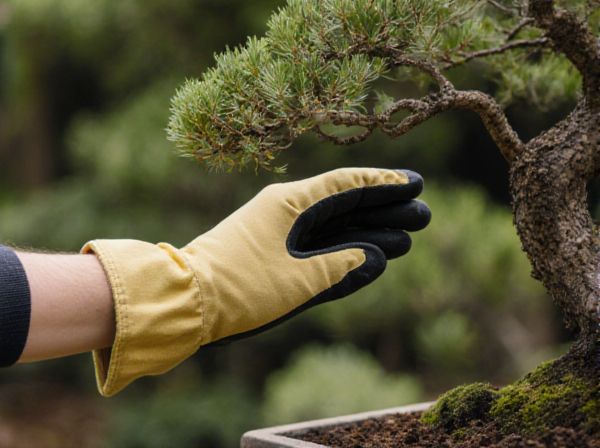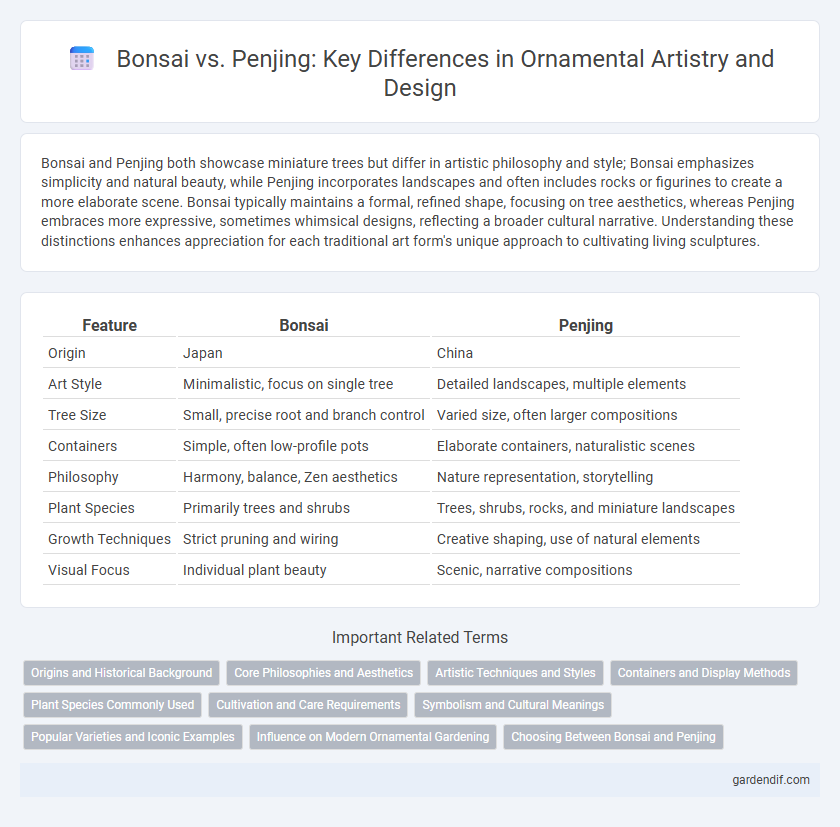
Bonsai vs Penjing Illustration
Bonsai and Penjing both showcase miniature trees but differ in artistic philosophy and style; Bonsai emphasizes simplicity and natural beauty, while Penjing incorporates landscapes and often includes rocks or figurines to create a more elaborate scene. Bonsai typically maintains a formal, refined shape, focusing on tree aesthetics, whereas Penjing embraces more expressive, sometimes whimsical designs, reflecting a broader cultural narrative. Understanding these distinctions enhances appreciation for each traditional art form's unique approach to cultivating living sculptures.
Table of Comparison
| Feature | Bonsai | Penjing |
|---|---|---|
| Origin | Japan | China |
| Art Style | Minimalistic, focus on single tree | Detailed landscapes, multiple elements |
| Tree Size | Small, precise root and branch control | Varied size, often larger compositions |
| Containers | Simple, often low-profile pots | Elaborate containers, naturalistic scenes |
| Philosophy | Harmony, balance, Zen aesthetics | Nature representation, storytelling |
| Plant Species | Primarily trees and shrubs | Trees, shrubs, rocks, and miniature landscapes |
| Growth Techniques | Strict pruning and wiring | Creative shaping, use of natural elements |
| Visual Focus | Individual plant beauty | Scenic, narrative compositions |
Origins and Historical Background
Bonsai originated in Japan and evolved from the Chinese art of Penjing, which dates back over a thousand years to the Tang Dynasty. Penjing, the Chinese precursor, emphasizes miniature landscapes with trees, rocks, and figurines to depict natural scenes, while Bonsai focuses on individual tree cultivation with refined aesthetics. Both art forms reflect deep cultural values, but Penjing offers broader artistic expression whereas Bonsai stresses simplicity and harmony.
Core Philosophies and Aesthetics
Bonsai emphasizes simplicity, balance, and the natural beauty of miniature trees, reflecting Japanese wabi-sabi principles that celebrate imperfection and tranquility. Penjing, on the other hand, embraces a more expressive and elaborate design with detailed landscapes, often incorporating rocks and water elements to symbolize natural scenes. Both art forms prioritize harmony with nature but differ in their philosophical focus and aesthetic execution, with bonsai leaning towards minimalism and penjing towards storytelling and complexity.
Artistic Techniques and Styles
Bonsai emphasizes meticulous pruning, wiring, and shaping to create miniature trees that reflect natural landscapes with simplicity and harmony, often highlighting asymmetry and subtlety. Penjing incorporates a broader artistic approach, combining trees, rocks, and figurines to craft detailed, narrative scenes that evoke dramatic and expressive aesthetics. Both traditions use distinct styles, where Bonsai favors refined minimalism while Penjing embraces elaborate compositions rich in cultural symbolism.
Containers and Display Methods
Bonsai containers typically emphasize simplicity and uniformity, often featuring shallow, unglazed pots designed to highlight the tree's natural form and balance. In contrast, Penjing containers vary widely in shape, size, and decoration, reflecting artistic expression and often incorporating elaborate landscapes or miniature scenes. Display methods for bonsai prioritize minimalism and harmony, using traditional wooden stands, whereas penjing presentations may include diverse elements such as rocks, figurines, and custom trays to create comprehensive, narrative displays.
Plant Species Commonly Used
Bonsai typically features species such as Japanese maple (Acer palmatum), juniper (Juniperus), and pine (Pinus), prized for their small leaves and elegant, refined shapes. Penjing often incorporates a wider variety of native Chinese plants like chinese elm (Ulmus parvifolia), boxwood (Buxus sinica), and azalea (Rhododendron indicum), emphasizing artistic landscapes and naturalistic forms. The choice of species in each art form reflects cultural preferences and the desired aesthetic complexity.
Cultivation and Care Requirements
Bonsai cultivation emphasizes meticulous pruning, wiring, and controlled watering to shape miniature trees, requiring consistent attention to soil quality and humidity levels to mimic natural environments. Penjing care involves broader artistic elements, including landscape arrangement and integrating rocks or figurines, demanding flexible watering schedules tailored to diverse plant species. Both traditions prioritize balance between aesthetic expression and the plant's health, but Penjing often allows more natural growth forms compared to the disciplined shaping typical of Bonsai.
Symbolism and Cultural Meanings
Bonsai symbolizes harmony, balance, and the beauty of nature in miniature, reflecting Japanese aesthetics and Zen philosophy deeply rooted in tranquility and contemplation. Penjing represents the essence of Chinese artistic expression, emphasizing natural landscapes, spiritual connection, and life's dynamic forces through intricate miniature scenes. Both art forms convey cultural narratives and philosophical ideals, with Bonsai focusing on refined simplicity and Penjing on expressive storytelling.
Popular Varieties and Iconic Examples
Bonsai, originating from Japan, features popular varieties such as Juniper, Ficus, and Japanese Maple, prized for their delicate foliage and refined shapes. Penjing, the Chinese counterpart, often showcases iconic examples like the Pine, Elm, and Azalea, known for their dramatic landscapes and naturalistic compositions. Both art forms emphasize miniature tree cultivation but differ in stylistic expression and cultural heritage.
Influence on Modern Ornamental Gardening
Bonsai and Penjing have profoundly influenced modern ornamental gardening by introducing principles of miniature tree cultivation and landscape design that emphasize natural beauty and artistic expression. Bonsai's meticulous shaping techniques inspire precision and elegance in garden aesthetics, while Penjing's broader stylistic approach incorporates detailed scenery elements, fostering creativity and thematic gardens. These traditional arts collectively enhance the diversity and sophistication of contemporary ornamental horticulture worldwide.
Choosing Between Bonsai and Penjing
Choosing between bonsai and penjing depends on your artistic goals and cultural preferences, as bonsai emphasizes minimalist, naturalistic tree shapes while penjing incorporates detailed landscapes and figurines. Bonsai practitioners often seek disciplined pruning and refinement, whereas penjing artists explore creative freedom with expressive scenes and varied plant species. Understanding these distinctions helps artisans select the most suitable style for their ornamental gardening projects.
Bonsai vs Penjing Infographic

 gardendif.com
gardendif.com